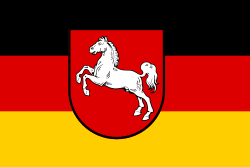Flag of Lower Saxony
The flag of Lower Saxony consists of the black, red and gold adopted from the flag of the Federal Republic of Germany , in which the Lower Saxony state coat of arms - the Sachsenross - is located, slightly shifted towards the mast . On land, this flag serves as both a national and an official flag.
The flag was first introduced on April 13, 1951 by the Provisional Lower Saxony Constitution , which came into force on May 1, 1951. The details of the flag have only been regulated since the law on coats of arms, flags and seals of October 13, 1952.
The service flag at sea is the state flag in the form of the double stand . While in other federal states at sea the German national flag is used as the main flag, and the state service flag is carried in a subordinate position, Lower Saxony is the only federal state to use its service flag at sea as the main flag.
history
This flag was designed in 1951 in order to obtain a neutral flag for the newly created state of Lower Saxony after the Second World War , which does not disadvantage or favor any of the previously independent parts of Hanover , Braunschweig , Oldenburg and Schaumburg-Lippe . Until the official introduction of the now valid flag of Lower Saxony, the state flags previously used in the respective areas were also widely used on official occasions. At the same time there was a yellow and white cross-striped flag based on the Welfisch- Hanover flag with the state coat of arms in the middle, which, however, was often rejected in the non-Hanover regions and was never officially designated as a flag. Today, the earlier national flags of Hanover, Brunswick, Oldenburg and Schaumburg-Lippes still have - albeit largely only folkloristic - meaning, for example at public festivals.
Web links
- Provisional Lower Saxony Constitution of April 13, 1951
- Law on Coats of Arms, Flags and Seals of October 13, 1952
- The flag on www.flaggenkunde.de
- Vexillological symbol after W. Smith, O. Neubecker: The signs of people and peoples. Our world in flags and banners . Reich, Luzern 1975, ISBN 3-7243-0115-4





